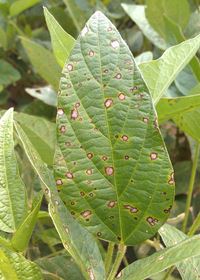MSU Conducting Survey To Find Resistant Fungus
MISSISSIPPI STATE, MISS.
A statewide survey that Mississippi State University began this
summer will continue next year as researchers look for a particular
fungal disease that is developing resistance to chemical control.
In 2012, soybean fields in two Mississippi counties were found to
have frogeye leaf spot fungi resistant to strobilurins, the class of
fungicides commonly used for late-season disease management in soybeans.
Jeff Standish, an MSU graduate student in plant pathology, is
involved in the ongoing project to track the distribution of frogeye
leaf spot and Cercospora sojina, the fungus that causes it. The
Mississippi Soybean Promotion Board funds this study through the
Mississippi Agricultural and Forestry Experiment Station.
“I am testing samples for strobilurin resistance, and if I find
resistant samples, I will sequence the gene to positively confirm the
presence of fungicide resistance,” Standish said.
This year, Standish collected 128 samples of frogeye leaf spot from
49 Mississippi counties where producers observed the disease. He
collected the greatest number of samples from Bolivar County, the
state’s biggest soybean producer. Frogeye was not observed in many
central and southeastern counties.

Frogeye leaf spot fungus, such as
the specimen seen on this leaf, causes serious yield losses when not
treated in soybeans. Mississippi State University is surveying to
monitor and limit the increasing resistance of the fungus to the
strobilurin class of fungicides commonly used for late-season disease
management in soybean fields.
Photo by MAFES/Sead Sabanadzovic
“Samples were returned to Starkville and cleaned and dried to remove
dirt and insects,” Standish said. “I put half of the leaves from each
sample in a moist chamber to promote fungal production of spores. The
other half was preserved for future analysis if needed.”
Standish took steps in the lab to isolate the pathogen so fungicide-sensitivity analyses can be made.
Trent Irby, soybean specialist with the MSU Extension Service, said
frogeye leaf spot can be a significant disease of soybeans.
“Frogeye leaf spot attacks the leaves, and percent yield reductions
can be directly correlated to the percentage of the leaves covered with
frogeye leaf spot,” Irby said. “This disease can have a major impact on
soybeans, but generally, it is more of a problem in fields planted to a
susceptible variety.”
Tom Allen, Extension plant pathologist at MSU’s Delta Research and
Extension Center in Stoneville, said the fungicide screening program
was initiated in Starkville and Stoneville during the 2013 growing
season.
“In the past, strobilurin fungicides have been suggested as a normal
management practice and were applied at R3, an important reproductive
growth stage,” Allen said. “In trials conducted during the 2013 soybean
season, fungicides with more of an ability to treat the disease –
notably the triazole class of fungicides – were more effective at
reducing yield loss when applied in the presence of frogeye.”
Allen said continued monitoring for the presence of strobilurin
resistance in frogeye leaf spot will provide soybean producers with
valuable information to help them manage the disease and reduce the
likelihood of yield loss or crop failure.
Maria Tomaso-Peterson, a MAFES researcher and Standish’s major
advisor, said the purpose of this research is to get ahead of fungicide
resistance in this disease before it develops.
“We’re being proactive in identifying whether or not we have strains
of this fungus that are resistant to the strobilurin fungicides, and if
so, to what extent,” Tomaso-Peterson said. “The fungal population
progressively develops resistance, allowing the resistant spores to
increase in numbers throughout a soybean field. This is called practical
resistance.”
The next step will be to develop a fungicide program that helps slow
down the development of practical resistance to the fungicide.
Fungi have a higher likelihood of becoming resistant to strobilurin
fungicides because this class of chemicals has what is known as a
“single-site mode of action,” which means it has only one way of
attacking disease-causing organisms.
“Strobilurin fungicides target fungal respiration, so we will use a
rotation of fungicides and tank mixes that include different classes of
fungicides,” Tomaso-Peterson said. “We also will suggest planting
resistant varieties, and where practical, using crop rotation, so
soybeans are not planted on the same land each year.”
Tomaso-Peterson said strobilurin resistance in turf grass pathogens
took only a few years to develop, but specialty crops such as turf grass
require many more fungicide applications each year than do row crops.
So far, it has taken more than 15 years for fungicide resistance to
manifest in soybean diseases.
“We suspect there is probably practical resistance to this fungicide,
and Jeff is doing this research to give us a better idea of the scope
of the problem,” she said.∆